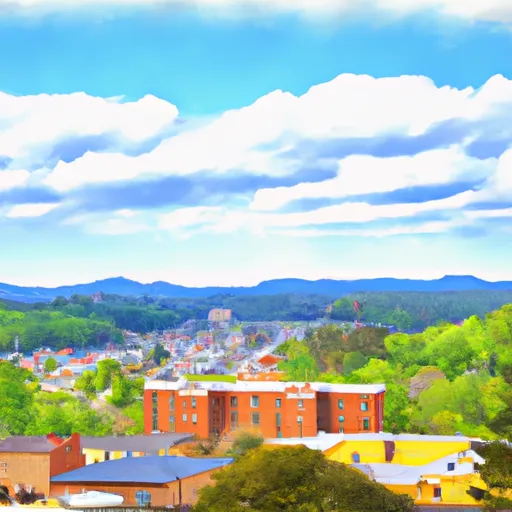-
 Snoflo Premium
Snoflo Premium
Get unlimited access to all our content
With no Ad interruptions! - Start Your Free Trial Login with existing account
Ringgold
Eden Index
Climate
7.9
•
Recreation
4.6
•
Community
3.2
•
Safeguard
5.6/10

Ringgold, Georgia is a charming city located in Catoosa County in the northwestern part of the state. The climate in Ringgold is characterized as humid subtropical, with hot and humid summers and mild winters. Average temperatures range from the 50s in winter to the 80s in summer, making it an ideal destination for outdoor activities year-round.
Ringgold is blessed with various hydrology constituents, including the beautiful Chickamauga Creek, which flows through the city. The creek not only provides a stunning backdrop, but it also offers opportunities for fishing, canoeing, and kayaking. Additionally, nearby Ringgold Lake provides a peaceful setting for boating and picnicking.
Outdoor recreation enthusiasts will find plenty of opportunities in Ringgold. The city is encompassed by stunning natural landscapes, including the scenic Chickamauga and Chattanooga National Military Park, offering hiking and biking trails. Furthermore, the nearby Fort Oglethorpe Recreation Complex boasts fields for various sports, including soccer and baseball.
In conclusion, Ringgold, Georgia's pleasant climate, water features, and outdoor recreation offerings make it an appealing destination for those seeking to connect with nature and enjoy a wide range of activities year-round.
What is the Eden Index?
The Snoflo Eden Index serves as a comprehensive rating system for regions, evaluating their desirability through a holistic assessment of climate health, outdoor recreation opportunities, and natural disaster risk, acknowledging the profound impact of these factors on livability and well-being.
Climate Health Indicator (CHI): 7.9
Ringgold receives approximately
1274mm of rain per year,
with humidity levels near 85%
and air temperatures averaging around
15°C.
Ringgold has a plant hardyness factor of
7, meaning
plants and agriculture in this region tend to thrive during the non-winter months.
By considering the ideal temperature range, reliable water supplies, clean air, and stable seasonal rain or snowpacks, the Climate Health Indicator (CHI) underscores the significance of a healthy climate as the foundation for quality living.
A healthy climate is paramount for ensuring a high quality of life and livability in a region, fostering both physical well-being and environmental harmony. This can be characterized by ideal temperatures, reliable access to water supplies, clean air, and consistent seasonal rain or snowpacks.
Weather Forecast
Streamflow Conditions
Middle Tennessee-Hiwassee
Area Rivers
Middle Tennessee-Hiwassee
Snowpack Depths
Middle Tennessee-Hiwassee
Reservoir Storage Capacity
Middle Tennessee-Hiwassee
Groundwater Levels
Recreational Opportunity Index (ROI): 4.6
The Recreational Opportunity Index (ROI) recognizes the value of outdoor recreational options, such as parks, hiking trails, camping sites, and fishing spots, while acknowledging that climate plays a pivotal role in ensuring the comfort and consistency of these experiences.
Access to outdoor recreational opportunities, encompassing activities such as parks, hiking, camping, and fishing, is crucial for overall well-being, and the climate plays a pivotal role in enabling and enhancing these experiences, ensuring that individuals can engage in nature-based activities comfortably and consistently.
Camping Areas
| Campground | Campsites | Reservations | Toilets | Showers | Elevation |
|---|---|---|---|---|---|
| Blanton Creek Park | 50 | 561 ft | |||
| Burnt Village | 120 | 687 ft | |||
| R Shaefer Heard | None | 640 ft | |||
| Spring Villa Campground | 24 | 604 ft | |||
| Amity | None | 689 ft | |||
| Pyne Road Park | 24 | 711 ft | |||
| Whitetail Ridge | None | 694 ft | |||
| McIntosh Reserve Park | None | 715 ft | |||
| Chattahoochee Bend State Park | 50 | 928 ft | |||
| Brush Creek County Park | None | 693 ft |
Nearby Ski Areas
Catastrophe Safeguard Index (CSI):
The Catastrophe Safeguard Index (CSI) recognizes that natural disaster risk, encompassing floods, fires, hurricanes, and tornadoes, can drastically affect safety and the overall appeal of an area.
The level of natural disaster risk in a region significantly affects safety and the overall livability, with climate change amplifying these risks by potentially increasing the frequency and intensity of events like floods, fires, hurricanes, and tornadoes, thereby posing substantial challenges to community resilience and well-being.
Community Resilience Indicator (CRI): 3.2
The Community Resilience Indicator (CRI) recognizes that education, healthcare, and socioeconomics are crucial to the well-being of a region. The CRI acknowledges the profound impact of these elements on residents' overall quality of life. By evaluating educational resources, healthcare accessibility, and economic inclusivity, the index captures the essential aspects that contribute to a thriving community, fostering resident satisfaction, equity, and social cohesion.

